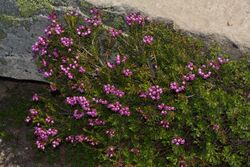Biology:Phyllodoce empetriformis
| Phyllodoce empetriformis | |
|---|---|

| |
| Scientific classification | |
| Kingdom: | Plantae |
| Clade: | Tracheophytes |
| Clade: | Angiosperms |
| Clade: | Eudicots |
| Clade: | Asterids |
| Order: | Ericales |
| Family: | Ericaceae |
| Genus: | Phyllodoce |
| Species: | P. empetriformis
|
| Binomial name | |
| Phyllodoce empetriformis (Sm.) D. Don
| |
| Synonyms | |
| |
Phyllodoce empetriformis, also known as pink mountain heather, gets its name from its red and pink bell-shaped flowers. It is found along the Rocky Mountains of the Northwestern United States and Western Canada.
Phyllodoce empetriformis is a low matting shrub with distinctive leaves which are pine needle like. It bears attractive flowers in shades of pink and purple.
It is one of the parents of the artificial hybrid × Phyllothamnus erectus, the other being Rhodothamnus chamaecistus.[1]
Description
This common evergreen alpine shrub bears its red-purple flower clustered at the end of the stem.[2] The flowers of the Phyllodoce empetriformis can grow in clusters of many to as little as one.[3] The leaves alternate on the stem and roll under themselves so tightly they resemble pine needles. It is a fairly short shrub that grows from 10–40 cm tall.[4] The dwarf shrub can survive in subalpine to alpine regions because of their ability to minimize water loss through evaporation.[4] It thrives under heavy snow cover which then waters the plant in the summer when the snow melts.[5]
Importance
Phyllodoce empetriformis is helpful in eliminating mountainous soil erosion. The heather acts as a mountain canopy and collects stone-free soil either from the wind or that has been washed in. This stimulates vegetative growth and may take up to one hundred years to reach full mature status. Pink mountain heather is easily damaged by natural causes such as a dry winter. It can also be affected by humans like getting stepped on. This can result in the decrease of coverage on a mountain and any slight wind can erode the loose sediment away.[6]
Similar Species
Pink mountain heather can often be mistaken for Empetrum nigrum (crowberry),[4] although Phyllodoce empetriformis does not produce berries. A closely related species is the Phyllodoce glanduliflora (yellow mountain heather). This species can be identified by its yellow, urn-shaped flowers. Pink and yellow mountain heather can form a hybrid called Phyllodoce intermedia.[7] It produces flowers that are white with pink sepals.
-
Pink mountain heather close up
-
Pink mountain heather adapting to environment
-
Yellow mountain heather
References
- ↑ "× Phyllothamnus erectus (Lindl. & Paxt.) C.K.Schneid..", Plants of the World Online (Royal Botanic Gardens, Kew), https://powo.science.kew.org/taxon/urn:lsid:ipni.org:names:331636-1, retrieved 2022-11-20
- ↑ Hitchcock, C. Leo; Cronquist, Arthur (1973). Flora of the Pacific Northwest: An Illustrated Manual. Seattle and London: University of Washington Press. ISBN 0-295-95273-3. https://archive.org/details/floraofpacificno00hitc.
- ↑ "Pink mountain-heather • Phyllodoce empetriformis" (in en). https://www.centralcoastbiodiversity.org/pink-mountain-heather-bull-phyllodoce-empetriformis.html.
- ↑ 4.0 4.1 4.2 Kershaw, MacKinnon, Pojar, Linda, Andy, Jim (2016). Plants of the Rocky Mountains (New ed.). China: Partners Publishing. pp. 77. ISBN 978-1-77213-029-4.
- ↑ Region, United States Forest Service Pacific Northwest (1979) (in en). Recreational Impact on Wildlands: Conference Proceedings : October 27-29, 1978, Seattle, Washington. Department of Agriculture, Forest Service, Pacific Northwest Region. https://books.google.com/books?id=u25xa_d770UC&dq=red+heather+phyllodoce+empetriformis&pg=PA101.
- ↑ Region, United States Forest Service Pacific Northwest (1979) (in en). Recreational Impact on Wildlands: Conference Proceedings : October 27-29, 1978, Seattle, Washington. Department of Agriculture, Forest Service, Pacific Northwest Region. https://books.google.com/books?id=u25xa_d770UC&dq=red+heather+phyllodoce+empetriformis&pg=PA101.
- ↑ "Washington Flora Checklist". https://burkeherbarium.org/waflora/checklist.php?Taxon=Phyllodoce%20intermedia.
External links
Wikidata ☰ Q3010198 entry
 |




